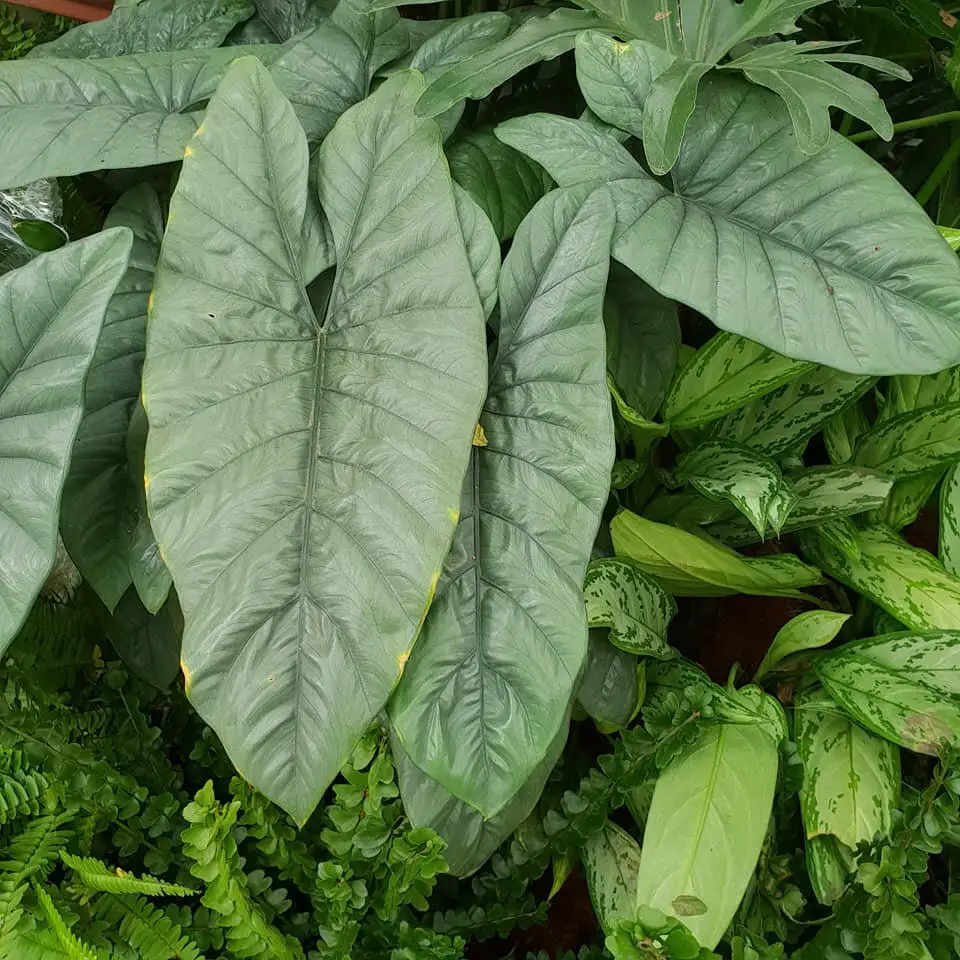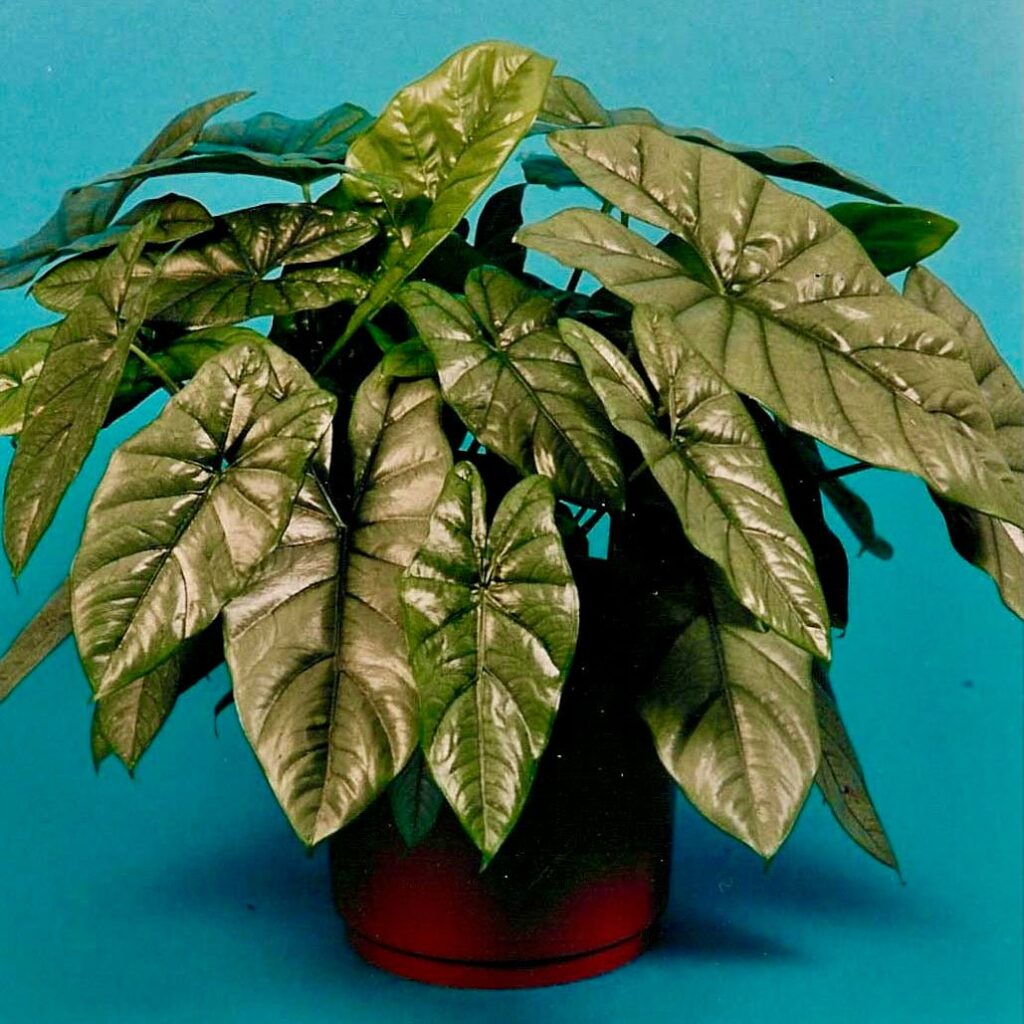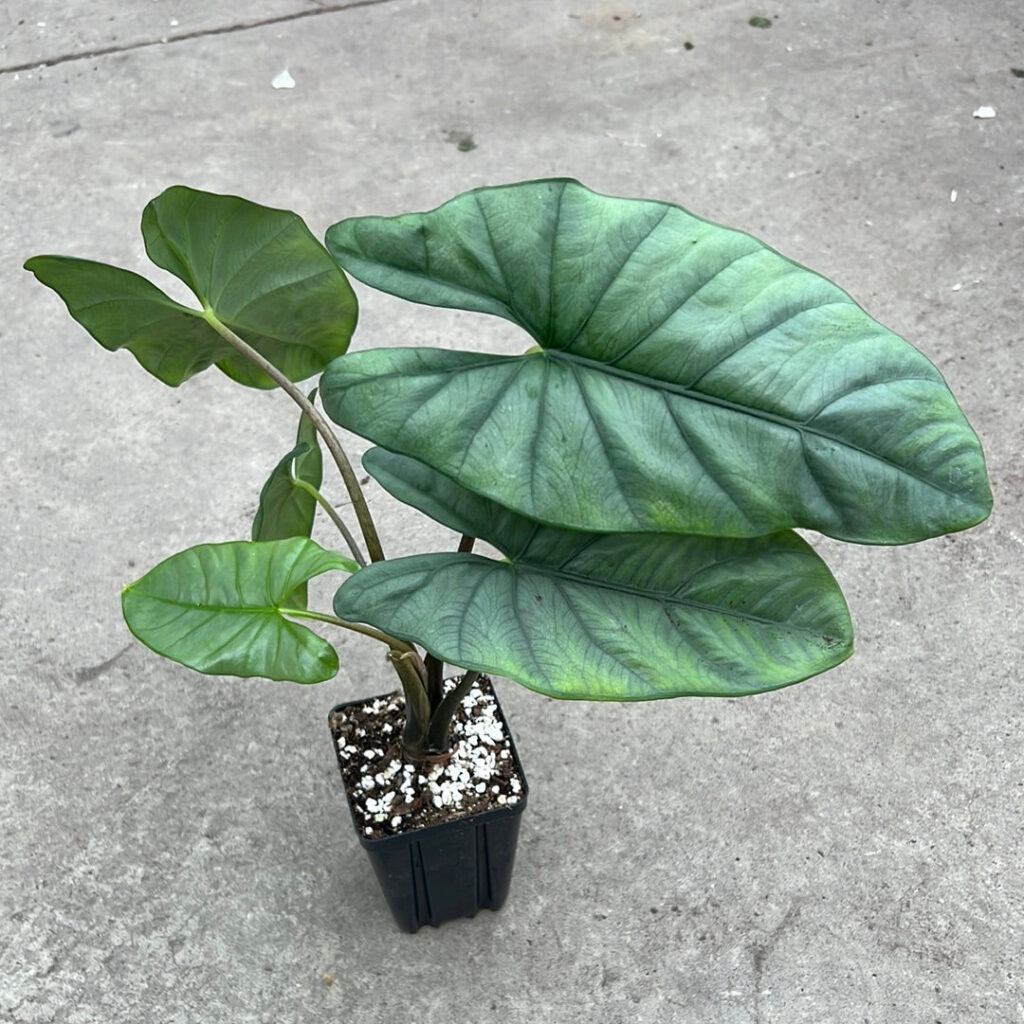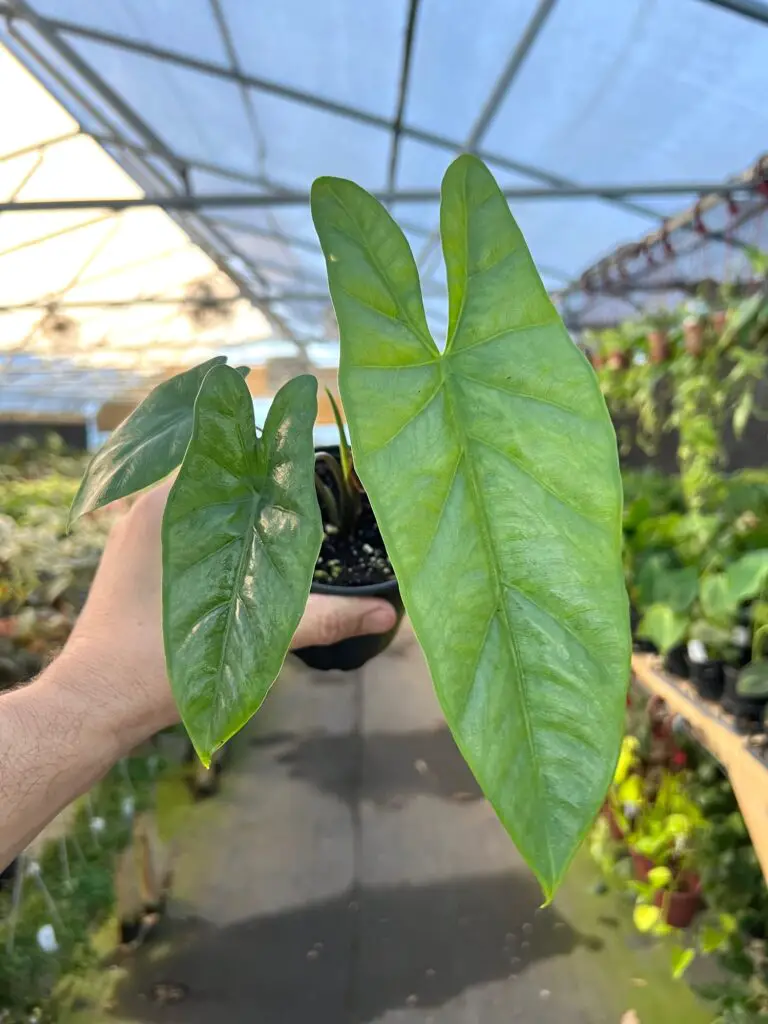To care for a Corazon Alocasia, provide bright indirect light, maintain humidity, and water when the top inch of soil dries out. Fertilize during the growing season and ensure well-draining soil to prevent root rot.
Understanding Corazon Alocasia
The Corazon Alocasia, also known as Alocasia ‘Heart’, is a striking tropical plant that has gained popularity among plant enthusiasts. This plant is appreciated for its unique heart-shaped leaves and stunning foliage. Native to Southeast Asia, it thrives in warm, humid environments, making it an ideal houseplant for those who can replicate its natural habitat.

One of the reasons for its rarity is the specific care it requires. Many plant lovers are drawn to this exotic beauty, but not everyone knows how to provide the proper conditions for it to flourish. Understanding its needs is crucial to enjoying this plant’s vibrant presence in your home.
Corazon Alocasia plants can grow quite large, which adds to their visual appeal. However, this growth requires attention and care. Here are some key characteristics of the Corazon Alocasia:
| Characteristic | Description |
|---|---|
| Leaf Shape | Heart-shaped leaves |
| Height | Can reach up to 3 feet |
| Light Requirements | Bright indirect light |
| Humidity Level | High humidity preferred |
| Watering Needs | Water when top inch of soil is dry |
Caring for a Corazon Alocasia involves understanding its environmental preferences and adjusting your care routine accordingly. This plant can be sensitive to changes in its surroundings. Therefore, creating a stable environment is essential for its growth and longevity.

In addition to the right light and humidity, the Corazon Alocasia benefits from a specific type of soil. Using a well-draining potting mix is crucial to prevent root rot. A mixture that includes peat moss, perlite, and orchid bark will help maintain moisture while allowing excess water to escape.
Optimal Conditions for Growth
For your Corazon Alocasia to thrive, consider these optimal conditions:
- Temperature: Keep the temperature between 65°F to 80°F (18°C to 27°C).
- Humidity: Aim for humidity levels above 50%. A humidifier or pebble tray can help achieve this.
- Watering: Water regularly but ensure the pot has drainage holes to prevent standing water.
- Fertilization: During the growing season, fertilize every four to six weeks with a balanced liquid fertilizer.
Each of these factors plays a significant role in the health of your Corazon Alocasia. Monitoring and adjusting them will help you create an environment where this rare plant can thrive.

As you cultivate your Corazon Alocasia, be mindful of its unique needs. Each plant is an individual, and observing its growth will guide you in providing the best care possible. By ensuring that it receives adequate light, water, and humidity, you can enjoy the beauty of this remarkable plant in your home.
Common Pests and Diseases
Like many houseplants, the Corazon Alocasia can be susceptible to pests and diseases. Recognizing these issues early can help you manage them effectively and keep your plant healthy. Here are some common pests that may affect your Corazon Alocasia:
- Spider Mites: These tiny pests thrive in dry environments. Look for webbing on the leaves and stippled yellow spots.
- Mealybugs: These pests appear as white, cottony masses on the leaves and stems of the plant.
- Scale Insects: Scale insects can be identified by their hard shell-like appearance, often found on the undersides of leaves.
- Aphids: These small, soft-bodied insects can cause distorted growth and may excrete a sticky residue known as honeydew.
To manage these pests, consider the following methods:
- Regular Inspection: Check your plant frequently for any signs of pests.
- Cleaning Leaves: Wipe down the leaves with a damp cloth to remove dust and any potential pests.
- Insecticidal Soap: Use insecticidal soap or neem oil to treat infestations. Apply according to instructions for safety and effectiveness.
- Isolation: If you discover pests, isolate the affected plant to prevent them from spreading to other plants.
Soil and Potting Tips
The choice of soil and potting is crucial for the health of your Corazon Alocasia. A well-draining mix helps prevent root rot, which is a common issue for this plant. Here are some tips for selecting the right soil and potting techniques:

- Soil Type: Use a high-quality potting mix that contains peat moss, perlite, and orchid bark. This combination retains moisture while allowing excess water to drain away.
- Pot Selection: Choose a pot with drainage holes to prevent water accumulation at the bottom.
- Repotting: Repot every one to two years or when you notice roots growing out of the drainage holes. This refreshes the soil and provides more space for growth.
When repotting your Corazon Alocasia, follow these steps:
- Gently remove the plant from its current pot, taking care not to damage the roots.
- Inspect the roots for any signs of rot or disease. Trim away any unhealthy roots with sterilized scissors.
- Add fresh potting mix to the new pot, ensuring it has good drainage.
- Place the plant in the center of the pot and fill in with more potting mix, packing it lightly around the roots.
- Water thoroughly after repotting to help settle the soil around the roots.
Watering Techniques
The watering needs of your Corazon Alocasia are vital for its overall health. This plant prefers consistently moist soil but is sensitive to overwatering, which can lead to root rot. Here are some techniques for effective watering:
- Check Soil Moisture: Always check the top inch of soil before watering. If it feels dry, it’s time to water.
- Watering Method: Water deeply until you see excess water draining from the bottom of the pot. This ensures that moisture reaches all parts of the root system.
- Avoid Watering Leaves: Focus on watering the soil directly rather than wetting the leaves to prevent fungal issues.
During the winter months, your Corazon Alocasia may require less frequent watering due to lower light levels and cooler temperatures. Adjust your routine accordingly, but always monitor the soil moisture closely.
Fertilizing Your Corazon Alocasia
Fertilization plays an essential role in promoting healthy growth for your Corazon Alocasia. During its active growing season, typically spring and summer, you should provide adequate nutrients. Here are some tips for fertilizing:
- Type of Fertilizer: Use a balanced liquid fertilizer diluted to half strength. This prevents over-fertilization, which can harm the plant.
- Frequency: Fertilize every four to six weeks during the growing season. Reduce or stop fertilizing in fall and winter when plant growth slows down.
- Application: Apply fertilizer to moist soil to avoid root burn. Water your plant a day before fertilizing if the soil feels dry.
By following these fertilization practices, you will encourage vibrant growth and enhance the overall health of your Corazon Alocasia.
Propagation Techniques for Corazon Alocasia
Propagating your Corazon Alocasia can be a rewarding experience. It allows you to expand your collection or share this beautiful plant with friends. There are a few effective methods for propagation, and understanding each will help you choose the best one for your situation.
Division Method
The most common method of propagating Corazon Alocasia is through division. This method involves separating the plant into smaller sections, each with its own root system. Follow these steps:
- Choose the Right Time: The best time to propagate is during the growing season, typically in spring or early summer.
- Remove from Pot: Gently take the plant out of its pot. Be careful not to damage the roots.
- Inspect the Roots: Check for healthy roots. If any roots are damaged or rotten, trim them away with sterilized scissors.
- Separate Sections: Locate natural divisions in the root ball and carefully separate them. Each section should have at least one healthy leaf and a portion of the root system.
- Replant: Plant each section in its own pot with fresh, well-draining soil. Water thoroughly after planting.
Offsets Method
Another way to propagate Corazon Alocasia is by using offsets, which are small plants that grow at the base of the main plant. Here’s how to do it:
- Identify Offsets: Look for small shoots or pups that have developed around the base of the parent plant.
- Carefully Remove: Gently separate each offset from the main plant, ensuring it has some roots attached.
- Pot the Offsets: Place the offsets in small pots with a suitable potting mix. Water them lightly to settle the soil around the roots.
Common Problems and Solutions
Caring for a Corazon Alocasia can sometimes lead to challenges. Being aware of potential problems and knowing how to address them will help you maintain a healthy plant.
Yellowing Leaves
If you notice yellowing leaves, it could be due to several factors:
- Overwatering: Check if the soil is too wet. Allow it to dry out before watering again.
- Nutrient Deficiency: A lack of nutrients can cause yellowing. Consider adjusting your fertilization routine.
- Pests: Inspect for pests that may be harming your plant. Treat accordingly if pests are found.
Browning Leaf Edges
Browning edges on leaves can indicate low humidity or underwatering. To remedy this issue:
- Increase Humidity: Use a humidifier or place a pebble tray under the pot filled with water to raise humidity levels.
- Adjust Watering Schedule: Ensure you are watering adequately based on the plant’s needs.
Root Rot
Root rot can be a serious problem for Corazon Alocasia. It often occurs due to overwatering and poor drainage. If you suspect root rot:
- Inspect Roots: Remove the plant from its pot and check the roots for black, mushy areas.
- Trim Affected Roots: Cut away any rotten areas with sterilized scissors.
- Repot in Fresh Soil: Replant in well-draining soil and adjust your watering habits moving forward.
Caring for Corazon Alocasia During Dormancy
Your Corazon Alocasia will enter a period of dormancy during the cooler months, usually in late fall and winter. During this time, care requirements change:
- Reduce Watering: Cut back on watering as the plant will require less moisture during dormancy. Allow the top few inches of soil to dry out before watering.
- Avoid Fertilizing: Stop fertilizing during this period, as growth slows down significantly.
- Maintain Temperature: Keep the plant in a warm location, avoiding cold drafts and sudden temperature changes.
Caring for your Corazon Alocasia during its dormant phase is crucial for its health and prepares it for vigorous growth when spring arrives.
Maintaining Your Corazon Alocasia Year-Round
While the Corazon Alocasia is a stunning addition to any plant collection, it requires consistent care throughout the year. Understanding the seasonal needs of your plant can help you create an environment where it thrives. Here are additional considerations for maintaining your Corazon Alocasia:
Seasonal Changes
As seasons change, so do the needs of your Corazon Alocasia:
- Spring: This is the ideal time for growth. Increase watering and start fertilizing as the plant begins its active growth phase.
- Summer: Continue to provide ample light and humidity. Monitor for pests, as warmer weather can lead to infestations.
- Fall: Gradually reduce watering as the plant prepares for dormancy. Stop fertilizing by mid-fall.
- Winter: Keep the plant in a warm location, reducing water and ensuring it remains away from cold drafts.
Environmental Factors
Aside from seasonal changes, various environmental factors can impact your Corazon Alocasia:
- Light Conditions: While bright indirect light is optimal, too much direct sunlight can scorch the leaves. Consider rotating your plant every few weeks to ensure even light exposure.
- Humidity Levels: If your home is dry, especially during winter months, consider using a humidifier to maintain moisture levels. Alternatively, grouping plants together can help create a more humid microclimate.
- Air Circulation: Good air circulation is important for preventing mold and pests. Ensure your plant has space around it for air to flow freely.
Final Thoughts
Caring for a Corazon Alocasia requires commitment and attention to detail. By providing optimal conditions such as suitable light, humidity, and soil, you can enjoy the beauty and uniqueness of this rare plant. Remember to adjust your care routine based on seasonal changes and monitor for any signs of pests or diseases.
The rewards of cultivating a Corazon Alocasia are numerous. With its heart-shaped leaves and striking appearance, it can become a centerpiece in your home or office. By following the care tips outlined in this article, you will not only enhance the health of your plant but also deepen your appreciation for the art of indoor gardening.
As you embark on your journey with the Corazon Alocasia, don’t hesitate to share your experiences with fellow plant lovers. Engaging with a community can provide additional tips and encouragement as you nurture your plant. Happy planting!
